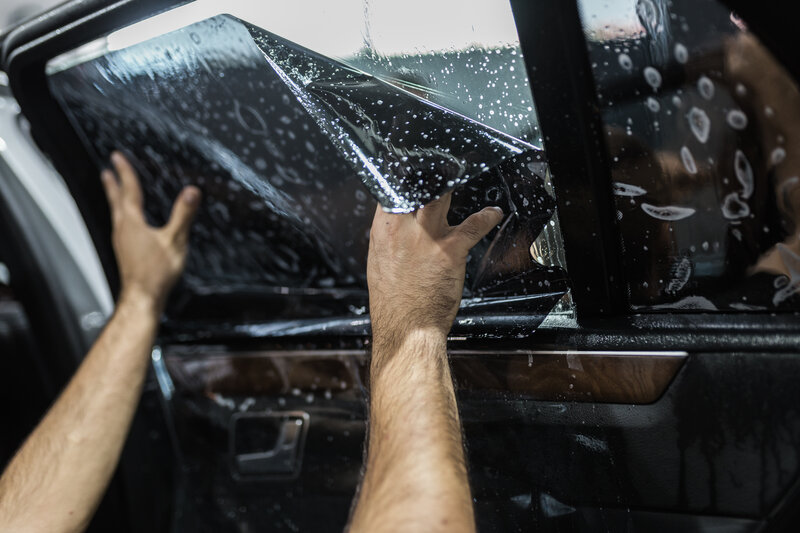The Most Effective Window Tinting Options for UV Security and Heat Decrease
Wiki Article
The Process of Professional Home Window Tinting Explained
Understanding the process of specialist window tinting needs a recognition for the intricacies associated with ensuring both aesthetic appeal and practical quality. From choosing the right movie kind to the meticulous prep work of home windows, each action plays a critical duty in accomplishing a flawless application. Complying with these initial prep work, the cautious cutting and application of the film need accuracy to stay clear of blemishes. However, the final inspection and advice on maintenance stay extremely important for long-term contentment. What variables add to the total efficiency of the tinting procedure, and how can they affect both aesthetics and efficiency?Selecting the Right Window Movie
The initial consideration is the type of movie, which can vary from dyed, metalized, to ceramic films (window tinting). Dyed films mostly offer personal privacy and aesthetic improvement, while metalized movies show heat and UV rays, improving power performance.Next, consider the film's Visible Light Transmission (VLT) percentage, which figures out just how much light goes into the room. A reduced VLT supplies greater personal privacy and warmth being rejected but might minimize natural light substantially. Additionally, the film's solar heat gain coefficient (SHGC) is vital; a reduced SHGC shows better thermal efficiency, helping to maintain indoor comfort.

Preparing the Windows
As soon as the ideal window movie has actually been chosen, the following step is completely preparing the windows for installation. This prep work is vital for accomplishing ideal attachment and making sure a perfect look post-installation.The very first task involves cleaning up the windows thoroughly (window tinting). A high-quality glass cleaner is vital, ideally one that is ammonia-free to avoid harmful any kind of window seals or color products. Using a lint-free fabric or paper towels, professionals need to get rid of any kind of dirt, dirt, or grease, paying special attention to the edges and edges where debris typically gathers

Cutting the Film
A specific technique to reducing the film is crucial for making sure an ideal fit on the ready windows. This step requires both skill and focus to detail, as errors can lead to unattractive spaces or overlaps that compromise the visual and functional high qualities of the tint.Before cutting, the expert should measure the home window measurements properly, representing any kind of special shapes or shapes. Learn More Here It is recommended to utilize high-grade window movie, as this material has a tendency to be much more flexible throughout the cutting procedure. The film is commonly laid flat on a tidy, smooth surface, and a sharp utility blade is used to guarantee clean edges.
To accomplish optimal results, numerous experts use layouts developed from previous installations or utilize software application to design accurate patterns. A common method includes adding an extra margin to the layout, permitting adjustments during the application phase.
In addition, reducing the movie in a regulated atmosphere minimizes the danger of pollutants affecting the glue side. By sticking to these thorough practices, window tinting experts can make sure that the movie not only fits perfectly yet additionally does successfully gradually, enhancing both appearance and performance.
Applying the Color
After diligently reducing the film to the correct measurements, the following action involves applying the tint to the window surface. This procedure begins with making sure that the home window is tidy and devoid of any dust, debris, or deposits that could affect adhesion. A specialized cleaning solution is typically utilized, complied with by complete drying out with a lint-free towel.Once the surface is prepared, the installer will thoroughly place the tint movie against the glass. It is vital to align the film accurately to avoid misplacement, as any mistakes can cause an amateur look. To promote this, the installer might make use of a light mist of application service on the sticky side of the film, permitting slight repositioning if needed.
Using a squeegee, the installer will then begin to press the film onto the glass, working from the facility outwards to get rid of air bubbles and make certain a company bond. This method is vital, as it assures a smooth and perfect surface. Throughout the application, focus to information is crucial to protect against creases or flaws, making certain that the color not only boosts appearances yet likewise supplies website link the preferred functionality.
Last Examination and Treatment
The final evaluation is a critical action in the window tinting process, ensuring that the setup meets both visual and functional standards. Throughout this stage, specialists thoroughly examine the set up color for any kind of imperfections, such as bubbles, folds, or misalignments. An extensive assessment also consists of inspecting the adherence of the movie to the glass, along with its harmony and overall look.After the examination, appropriate treatment and maintenance directions are given to the customer. It is vital to notify them concerning the recommended timeline for cleaning the tinted windows, generally recommending a wait of at least one month after installation to enable the adhesive to heal totally. Customers should be informed on ideal cleaning products and methods, stressing the evasion of ammonia-based cleaners that can harm the tint.
Furthermore, specialists need to advise clients on the relevance of normal upkeep to lengthen the life of the tint. This includes routine checks for signs of wear or damage and reacting immediately to any concerns. By making sure a detailed last examination and providing clear treatment standards, home window tinting specialists enhance client complete satisfaction and the durability of their job.
Final Thought
The expert window tinting process incorporates a number of essential steps that make sure high-quality outcomes. Picking the suitable movie type, preparing the home windows carefully, precisely reducing the film, and using it with accuracy are vital for accomplishing a Our site perfect finish. A detailed final examination guarantees that all criteria are satisfied, while appropriate post-installation care is essential for maintaining the color's long life and performance. Following these procedures inevitably improves both the aesthetic charm and functionality of the colored home windows.Report this wiki page